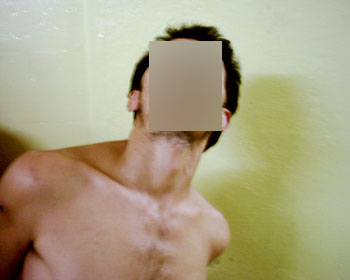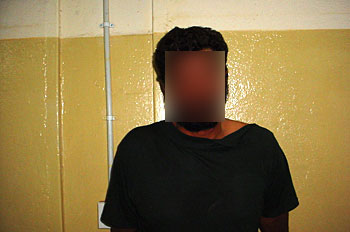You are currently browsing the tag archive for the ‘Interrogation’ tag.
The American Psychological Association (APA) Council of Representatives, on Friday, voted today in Toronto to adopt a new policy barring psychologists from participating in national security interrogations. That means psychologists won’t be approving torture techniques or overseeing “enhanced interrogations.” That means psychologists can, and must, refuse to work in such capacities for the U.S. military and they will have full backing of their professional body in so doing.
Democracy Now! covered the decision, here and here.
My favourite comment came not from any of the APA members but from Peter Kinderman, the president-elect of the British Psychological Society who was representing the BPS at the APA meeting.
“I think it’s wonderful. I think it’s great. I think it’s well overdue. I was joking earlier that this represents American psychologists rejoining the 17th century and repudiating torture as a means of state power. […] The agreement is that American psychologists would respect agreed international definitions of the abuse of detainees and agreed international standards for judicial process. We shouldn’t be involved in abusing detainees, and we should remain within domestic and international law. That strikes me as commonsense, obvious. It’s what the public would expect. And about bloody time, too.”
This time last year, I talked about the torture of Iraqis by the UK Army. The issue at hand then was specifically the death of Baha Mousa.
As part of court proceedings against the British Army into Mousa’s death, hundreds of films from the British interrogation centre in Basra have been released.
The Guardian has this report. [Warning: Content may be disturbing to some viewers.]
Only last week, I also noted the late to surface reports of US complicity in Iraqi upon Iraqi torture in Samarra.
It seems now we are starting to “see” a more varied picture of violence in Iraq. This is not the images of violence through the lenses of embedded journalists or through the sights of military aircraft, but images/footage of bullying; personalised verbal and physical abuse of men behind closed doors.
Without doubt, the most indelible images of the Iraq war are those from Abu Ghraib; they are the images the world remembers, will always remember.
Likewise, these videos of interrogation and of the uninhibited darker side of standard operations are key to understanding the facts of the Iraq War.
Also read: British troops use torture – even if it is by another name
I have just watched Ghosts of Abu Ghraib, an HBO documentary made in 2007 by director Rory Kennedy.
It interviewed all the military police involved and prosecuted for the abuses, with the exception of Specialist Graner who remains in prison. It also features John Yoo, law and military scholars and Mark Danner.
It provides a voice to the military police who were portrayed as “bad apples” on the Abu Ghraib night-shift. It does not allow the military leadership off the hook.
The close of the film concentrates on the fact that no investigation followed the chain of command to the Pentagon, from where Rumsfeld’s Department of Defense had signed off on the most brutal interrogation techniques in US history.
In the first round of Pentagon memos, Rumsfeld questioned why the standing stress position would be limited to ONLY four hours!

Rumsfeld is a worm and you can quote me on that.
On Thursday, 28th May, photographs of prison conditions and detainee custody from six facilities other than Abu Ghraib will be released to the public.
Reports over the weekend suggested a figure of 44, but the Guardian has stated over 2,000 photographs are to be made public. Images of Bagram Air base in Afghanistan are included in the cache. Critics will surely scan for similarities in detention/torture methods used in Afghanistan as in Iraq to argue against the ‘few bad apples’ logic that railroaded earlier attempts to bring military and government commanding authorities to full-accountability.

ACLU’s advocacy deserves international acclaim. Not only have they forced the release of photographic evidence they won a ruling to prevent the destruction of audio tapes that record torture scenarios.
This is an interesting counterpoint. I presume we all assume we’ll see the images in the printed press. Would we expect the tapes to play on our televisions and radios? That scenario makes me uncomfortable.
Continuing with issues of format, it will be interesting to see how the media presents the-soon-to-be-released photographic documents in contrast to the recent torture memo’s. WoWoWoW set the bar low with the tabloid inquiry “How Bad Will They Be?” and the Los Angeles Times allays fears with a dead-pan assessment, “examined by Air Force and Army criminal investigators, are apparently not as shocking as those taken at Abu Ghraib.
No doubt these images will be contested and a ‘Meaning-War’ over the images will ensue, but I think people for and against the Bush administration’s interrogation policies are not going to change their position now – whatever the evidence.”
But, I guess it depends who’s looking.

Lefties want more weaponry in the push for prosecution of Bush and his cronies for war crimes. The right is debilitated and otherwise occupied by the economy, stocking guns before the “Obama-ban” and the latest Meghan McCain slur.
Politicians from both parties seem to want this to go away, snarking on about how the release of yet more Un-American activities will only fuel the burning hate toward the US. This position is an insult.
Did Bush care what Iraqi’s would think when he bombed them out of house and home? Did Bush care to think how American’s would react in the face of diminished civil liberties? Yet here, politicians of both parties are scrambling to avoid the negative reactions of entrenched, fundamental opponents INSTEAD of anticipating the beneficial good-will and return to mutual trust provided by honest disclosures of a transparent and constitutional government. Why cover-up a cover-up?
Maybe, the Democrats are shy to see these documents because they may implicate their top brass?

One concern I will air, is that all this could move toward some bizarre show-trial scenario, where lawyers bargain, Bush is spared, the American public settle for a conviction of Cheney, and careers and reputations lie in waste on both sides of the aisle!?!
I certainly didn’t expect the incriminating documents to flood as they have in recent weeks. I have no idea how all this is going to shake down. Obama doesn’t seem to have control of this. That doesn’t bother me. No-one can hold back the truth.
So, as wise at it’d be to remember the date, 28th May, you should bear in mind the photographs of abuse could well leak earlier…
________________________________________________
First Image lifted from Gerry May. http://www.gerrymay.com/?p=1426
Cartoon courtesy of the Nation. http://www.thenation.com/doc/20050307/duzyj
Final Image by Takomabibelot. http://www.flickr.com/photos/takomabibelot/2090273618/














